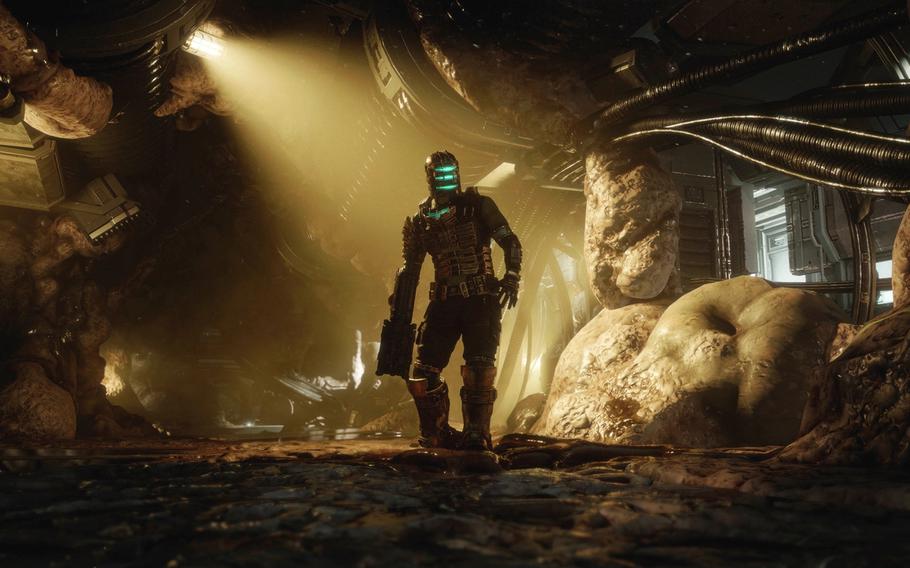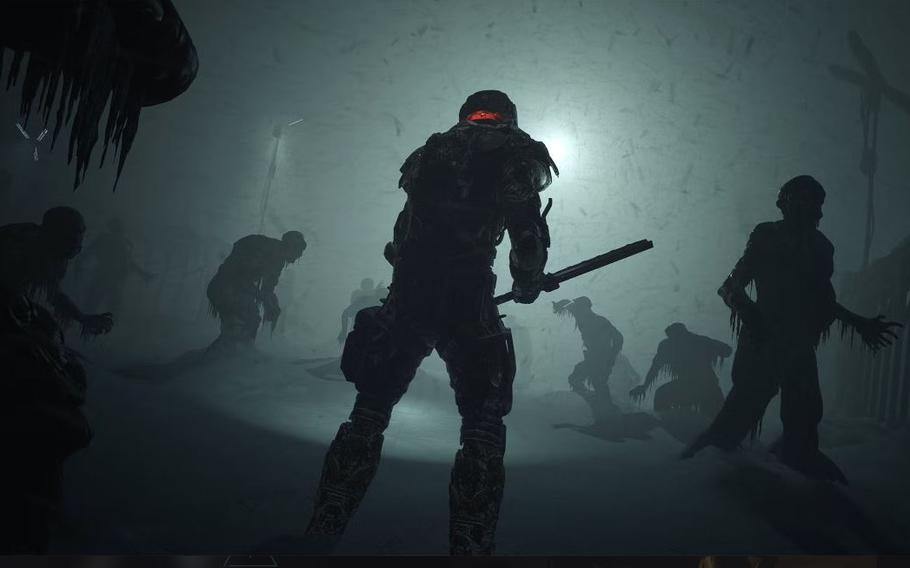
The Dead Space remake improves on the classic survival-horror game in several facets. (Electronic Arts)
It must be a strange time for Glen Schofield. The video game designer recently returned to the survival-horror genre with the release of The Callisto Protocol, and Electronic Arts, his former employer, just launched a remake of Dead Space, a project that helped define his career. In effect, his past and present are facing off, as the two games have come out within weeks of each other.
Both owe a huge debt to the 2008 original, which sets the mood and style of both new projects. The Callisto Protocol and the Dead Space remake both focus on mysterious outbreaks, in which humans, or their remains, metamorphize into horrific creatures. And they both star heroes who aren’t the typical space marine.
In The Callisto Protocol, Jacob Lee, played by Josh Duhamel, is a pilot who is wrongly imprisoned on Jupiter’s moon; Dead Space stars Isaac Clarke, voiced by Gunner Wright. He’s an engineer on a repair team sent to the USG Ishimura. These backgrounds give each protagonist an everyman quality. At first glance, they appear like regular people who fall prey to a catastrophe bigger than themselves.

The Callisto Protocol has some issues with movement, but is a better-looking game. (Striking Distance Studios)
A spiritual successor
Although the DNA of both games is similar, The Callisto Protocol manages to establish its own identity. Part of that comes from the melee-heavy combat system. Players quickly learn that the Biophage creatures are tough and can overwhelm Jacob. That means they’ll have to ambush adversaries by shivving them with stealth attacks. If that tack fails in close quarters, players will have to dodge attacks and counter with swings from a Stun Baton before following up the attacks with a firearm. Players also have a telekinetic power through a device called the Gravity Restraint Projector. With it, players can grab enemies and slam them on spikes or against each other.
For the most part, that combat system works, but the one big problem that hamstrings The Callisto Protocol is Jacob’s movement. He’s agonizingly slow and the fact that the developer, Striking Distance Studios, doesn’t include a quick turn makes exploration burdensome at times.
As in other survival-horror games, resource management is huge. Players will have to conserve ammo and find efficient ways to eliminate creatures. Upgrading weapons and abilities help on that front, but to gather enough funds players will need to sell contraband found around Callisto’s Black Iron Prison.
Another thing that separates The Callisto Protocol from Dead Space is the visual element. It’s a better-looking game that’s helped by the performances of the actors and the Unreal Engine that makes the visuals pop.
The campaign’s structure is linear, and that actually hurts the storytelling as Striking Distance Studios has to constantly find ways to move the action forward and separate Jacob from the allies he meets along the way. When that happens for the third time, it becomes a narrative device that’s redundant. One can only fall through the floor so many times. Despite its flaws, The Callisto Protocol feels like a new if imperfect take in a niche that Schofield pioneered.
A classic got better
When it comes to the Dead Space remake, EA makes a classic even better. The developers at Motive made several smart decisions to augment an already strong campaign. One of the bigger changes is that the protagonist, Isaac Clarke, is voiced, while in the original he was a silent protagonist.
That decision bolsters other tweaks to Dead Space as Clarke feels less alone as he boards and explores the derelict planet-cracker ship the USG Ishimura along with Zach Hammond and Kendra Daniels, the remnants of his repair crew. He also comes face to face with the Unitarians, a fanatical church whose members believe they have discovered an artifact called the Marker that’s key to their religion.
Unfortunately, that alien device messes with the human psyche and turns the dead into creatures called Necromorphs. Clarke faces more human villains in addition to the monsters lurking in the ship’s vents and hallways. It gives a memorable face to evil on board and adds more depth to the narrative as it lays the foundation for possible future games.
The big difference between Callisto Protocol and the Dead Space remake lies in the latter’s structure. Having Clarke explore a ship full of Necromorphs, fixing each of its sections and uncovering its mysteries, lends itself well to the survival-horror genre. It gives players a better sense of exploration and place as the protagonist makes the necessary repairs to open up more of the ship.
As for the combat, it remains largely untouched from the original. Players have to strategically dismember the monsters in order to stop them, and again, doing that efficiently is key because resources are limited on the adventure. Players will develop favorite weapons, but each of them, and their alternate firing modes, have their uses. Despite the number of options, it’s best for players to stick with a few in order to power them up fully.
In the end, the Dead Space remake works because it doesn’t slavishly follow the original. Developer Motive Studio rethought key moments and how it distributed some weapons and tools in order to create a more cohesive experience. The original wasn’t perfect and the team pinpointed the flaws in a great game so that the remake can reach new heights.
The Callisto Protocol
Platforms: PlayStation 5, PlayStation 4, Xbox Series X and Series S, Xbox One, PC
Online: callisto.sds.com
Dead Space
Platforms: PlayStation 5, Xbox Series X and Series S, PC
Online: ea.com/games/dead-space